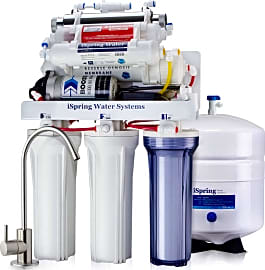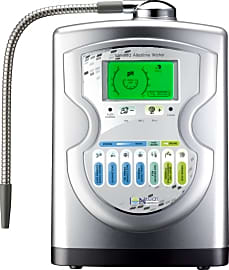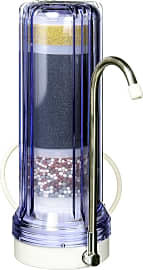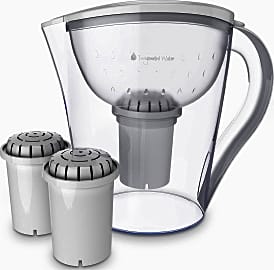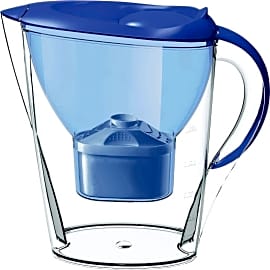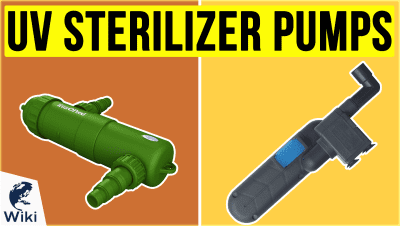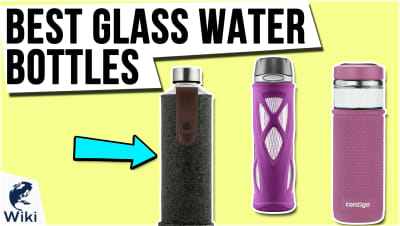The 10 Best Alkaline Water Filters

This wiki has been updated 38 times since it was first published in June of 2015. Although the theory lacks any scientific backing and is widely disputed by most doctors, proponents of alkaline water claim you can improve your health by using it to reduce the acid buildup in your body. We've put together a wide selection of ionizer machines, some of which go beyond alkalization to offer features like carbon filtration to produce clean-tasting water. When users buy our independently chosen editorial picks, we may earn commissions to help fund the Wiki.
Editor's Notes
February 21, 2020:
While the Air Water Life AWL-5000 is a fine model that might be the right fit for some users, we decided to let it go in favor of a pair of superior models from the same company in the Aqua Ionizer Deluxe 9.0 and the Aqua Ionizer Deluxe 9.5, the latter of which has an anti-oxidant boost capability to give you drinking water with a theoretically increased health benefit. We also lost the Alkamate Portable due to availability concerns and the fact that it took a while to process a small amount of water.
The iSpring 100GPD 7-Stage is an upgrade to the company's previous six-stage model, and the extra stage this unit offers creates a slightly tastier result thank to its UV sterilization capabilities. Whether or not mere alkalizing offers true benefits to health is still up for debate, but combining the process with other tried and true methods of removing contaminants and purifying your supply seems like the best way to go.
A Way To Tip The Scales
That means that tap water measuring at a 6.5 is 5 times more acidic than the center of the scale, and nearly 10 times more acidic than the 7.365 ideal pH level in humans.
Scientists and medical professionals maintain that Alkalized water is a fraud, but that hasn't stopped hundreds of thousands of confused people from plunking down money on systems to modify their water.
You may have heard that you can take a human tooth (let's say a baby tooth that's fallen out naturally), and drop it in a glass of Coke, leave it there overnight. By the next morning, the tooth will have (mostly) dissolved.
The first thing most people think of when they hear this is the sugar in Coke, and the sugar is certainly a problem. It's bad for just about everything in your system, but it only accelerates plaque build-up on your teeth; it won't disintegrate them. That's done by the acid in Coke.
Coke's an extreme example, as it actually has a high quantity of acid added to it. It's right there in the ingredients list. If there's anything you would assume to be pH balanced, to fall in a neutral territory between acidity and alkalinity, you'd expect it to be water. It tastes like nothing, right?
Well, the average tap water isn't too far off, but it does tip toward the acidic, coming in at about a 6.5 on the pH scale.
Remember: The pH scale runs from 0 to 14, with 0 being the most acidic and 14 being the most alkaline. 7 is right in the middle. The scale is also logarithmic, which means that each point in the scale is a factor of 10. A 6 is therefore 10 times more acidic than a 7. A 5 is 100 times more acidic than a 7. Got it?
That means that tap water measuring at a 6.5 is 5 times more acidic than the center of the scale, and nearly 10 times more acidic than the 7.365 ideal pH level in humans.
Advanced alkaline water filters utilize a simple ionization process to split incoming water into two streams, one of which is more alkaline and the other of which is more acidic. Some systems will capture the acidic water for you to use in cleaning procedures, while others simply discard it.
Alkaline pitchers work in a slightly different way, adding trace amounts of minerals to your tap water. The result is a glass of water rich in healthy minerals that alter the pH balance of your water in an alkaline direction.
To Filter Or To Ionize: That Is The Question
This big dilemma facing anyone interested in alkaline water is whether to invest in a complicated ionization system or to get your hands on a simple pitcher for alkaline filtration. The split really only comes down to two factors: cost and hassle.
It also only takes a few minutes to assemble a given pitcher, though you have to run water through it for about an hour's worth of cycles before you can safely drink from it.
When you invest in a more costly ionization system, the kind that hooks up to your incoming water line, usually under the kitchen sink (though sometimes at the house's intake, flowing alkaline water into the kitchen and the shower), you're going to pay a lot more money up front, and you have to go through a pretty agonizing installation process. Once it's installed, however, it's maintenance-free for up to several years depending on the system. That also means that you won't spend any more money on it until it's time to replace certain parts well down the line.
Filtration pitchers and coolers work on a slightly different principal. Since they use simple cartridges to add mineral content to tap water while filtering out impurities, they can be set up for use regardless of space below the sink. It also only takes a few minutes to assemble a given pitcher, though you have to run water through it for about an hour's worth of cycles before you can safely drink from it.
The major downside to filtration pitchers is the frequent cartridge replacement. After about two or three months of regular use, you'll need to grab a new cartridge, which can run you up to $100. Over the course of a few years, you'll actually have paid more for the filtration pitcher than you would to have alkaline water coming out of your tap.
Electrolysis Isn't Just For Hair Removal
Up to just a few years ago, electrolysis was all the rage in hair removal. Now, like a tremendous amount of the medical industry, it's being subsumed by laser technology. Perhaps lasers will someday play a role in water alkalinity, but, for now, we still use electrolysis to divide the acidic water from its healthier counterpart.
Human beings on the other hand require alkaline water to fight against the myriad sources of blatant acidity found in our daily food supply.
The process of electrolysis to divide water into its separate atomic constituents was developed by an English scientist named Michael Faraday in the early years of the 19th century.
Around 100 years later, scientists in Japan began to use electrolysis to acquire a more acidic water for use in botanical preservation. They found that freshly cut flowers stayed perky longer in more acidic water, and that grass stayed greener longer in the same conditions.
Of course, these plants have a naturally alkaline bent, which is why they thrived in a comparatively acidic environment. Human beings on the other hand require alkaline water to fight against the myriad sources of blatant acidity found in our daily food supply.
Ionization for alkalinity took the far east by storm throughout the 1990s, and western health experts soon began proclaiming the many benefits of alkaline water. Nowadays, you can buy tremendously expensive bottles of water that's been through an ionization process, but you stand to save a lot more money by investing in any one of these great systems.




